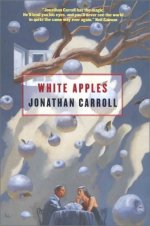
| White Apples | ||||||||
| Jonathan Carroll | ||||||||
| Tor Books, 304 pages | ||||||||
|
A review by William Thompson
Carroll has marvelously recreated this cosmology within the compositional structure to his novel, which is an ever-shifting kaleidoscope of events
and perspective, slipping the constraints of time, corporal existence and reality. Storylines and beliefs are built, exploded and
seemingly destroyed, only to reemerge again in new and evolving forms entirely unanticipated. One page's truth becomes another page's
fiction, and in less masterful hands the protean nature of Carroll's plotting would become utterly lost in their transience or seeming
evanescence, creating a narrative chaos, which also becomes an informing element to the novel, both in the storyline as well as the
narrative's construction. With a deftness that can only be described as sheer brilliance, the author has written a novel that in its
interweaving and metamorphic structure intentionally mimes its own thematics, the world of the word reflecting the writer's own
ongoing cosmogony. The ingenuity of this device, combined with the author's ability to pull it off, frankly leaves one awed.
A posthumous fable of resurrection, a meditation upon the nature of memory and identity, and a frank and at times moving affirmation
of the redemptive power of love, this parable is framed equally by the author's vision of a moral universe that extends beyond the
theories of physics that also serve to inform it. Centered primarily around the struggles of a couple, one of whom is deceased, to
come to terms with their relationship and, for at least one of them, uncertain existence, the novel opens with Vincent Ettrich, a
master of the male gaze, whose love of women has led him into yet another affair that soon takes a decidedly bizarre turn. While
dining with his new-found femme, Vincent bumps into a business acquaintance who appears very surprised to see him. No more surprised
than Vincent when he discovers that his friend is actually dead. Stunned, Vincent is predictably relieved when he awakens to discover
that this ghost is but a figment of a dream. But is it? To his horror, he finds his friend's name tattooed upon the back of his
lover's neck, and that he as well can no longer number himself among the living! As if this were not revelation enough for a single
lifetime, he cannot recall anything having to do with his passing nor how long he's been deceased, and no one seems aware of his
demise except for his equally lifeless associate and his new and suddenly alien girlfriend, who suggests she is there simply in the
role of chaperone. And, to make matters worse, the true love of his life, Isabelle Neukor, is flying in from Vienna, pregnant with their child.
As almost all of these events and more take place within a single chapter, they provide but a prelude to the rich rush of shifting
perspectives and evolving knowledge that punctuate this book. Like Vincent, one is suddenly uncertain of the verity of events or
the characters' changing roles within the narrative, changes that can occur several times within a chapter, and that are continually
taking the protagonists as well as the reader in directions impossible to predict. Again, in another's hands, it would be
easy to anticipate the narrative's disintegration into contrivance, or incidence hinging upon the preposterous, but somehow Carroll
is able to convince his audience that everything taking place follows a natural internal rhythm, regardless of the unexpected,
without skipping a beat adeptly segueing through dramatic action and new revelations as smoothly as he blurs the lines between
fantasy, horror, and science fiction, past and present, memory and reality, or science and metaphysics. In an act of imaginative
artistry that enthralls the reader forward, one is left continually wondering and waiting to know what will happen next, no scene
similar to the last, disbelief suspended in a world that unspokenly assumes all possibilities. Battles are waged in zoos between
animals and homunculus with a horror all too real, and several times Carroll trots out his sentient, signature dogs without the
reader once questioning their credibility within the realism of their setting.
As always, Carroll exhibits a seemingly effortless ability to infuse the common with the fabulous, like a gifted conjuror
convincing us the incredible is nevertheless all too possible. Using fabulation in a manner reminiscent of the magic realists,
the author offers insights into the human condition only enriched by their presentation as marvels. And while their outward
form may assume the guise of fantasy, the rules of his realms defying the logic by which we define and take familiar comfort in
the ordinary day-to-day, the richness of his allusions, and particularly the humanity through which he views his main characters,
bring us back, in some cases perhaps uncomfortably close, to our own flawed and heroic existence. While White Apples is not
without its debatable missteps -- a tendency towards using the character of Coco for infomercials, or a tone at times resembling
a New Age mystic -- difficult to imagine reading a better book this year. His success at crafting the novel to reiterate its own
cosmology alone is worth the price of admission.
William Thompson is a writer of speculative fiction. In addition to his writing, he is pursuing masters degrees in information science as well as history at Indiana University. |
|||||||
|
|
If you find any errors, typos or anything else worth mentioning,
please send it to editor@sfsite.com.
Copyright © 1996-2014 SF Site All Rights Reserved Worldwide
